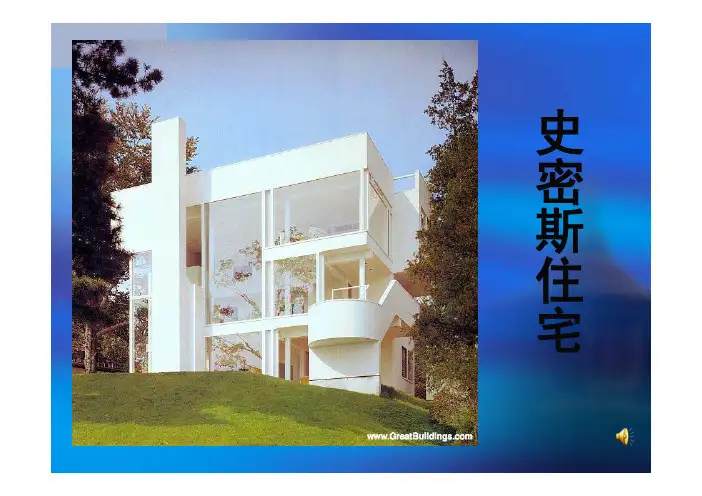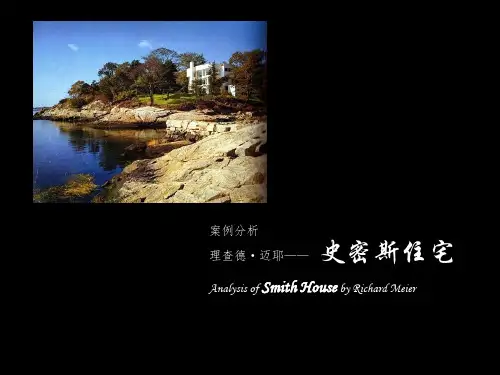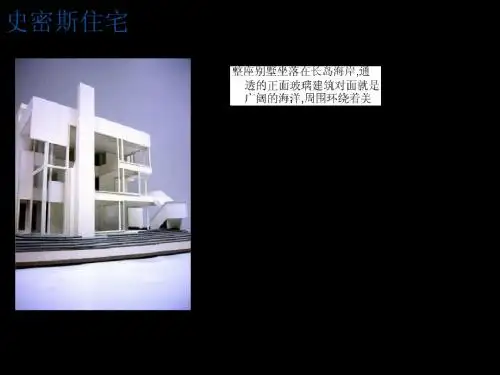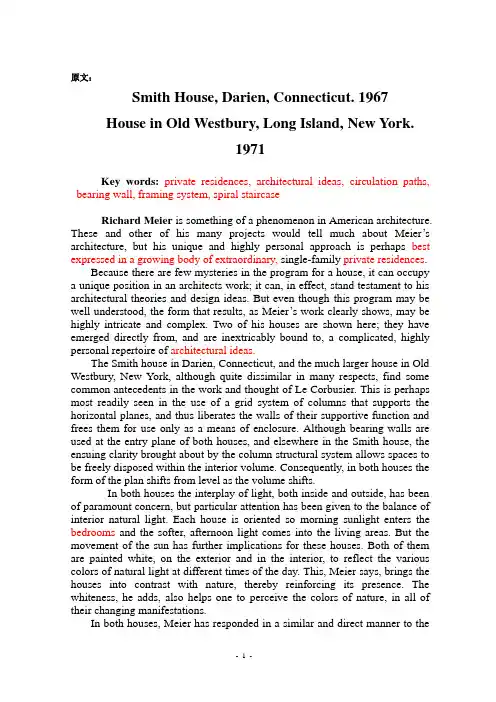史密斯住宅资料文档
- 格式:ppt
- 大小:4.82 MB
- 文档页数:47

史密斯住宅简介史密斯住宅是位于美国伊利诺伊州芝加哥市的一幢历史建筑,建于1893年,是芝加哥地区著名的建筑大师马修斯及他的合伙人路易斯·斯伯格恩的杰作之一。
它的地址是211 Greenwood Avenue, Wilmette, IL 60091。
史密斯住宅的建筑风格是美国文艺复兴时期的古希腊复兴式,它是一幢两层高的砖结构建筑,面积约为5,800平方英尺,内部共有18个房间。
它的拱门入口和双层花园门廊彰显了该建筑主人的地位和财富,建筑风格与周边环境相得益彰。
大门处还有一个露天阳台,可以看到美丽的花园和小路的风景。
内部设计十分舒适,可以体验到当时美国上流社会生活的奢华。
从宽敞高大的客厅到壁炉和书房,到晚餐厅,到充满玻璃的花房,史密斯住宅以其宽阔、尊贵和独特的设计和装饰特点,使客人们感到温暖、舒适、自由和轻松。
它的外围设计和内部装饰都非常奢华,显然花了大量的资金,从木制天花板到大理石柱子,到宝石饰品和雕刻的家具,每个细节都显示着琳琅满目的美学品味。
在该建筑中,所有的细节都被照顾到,使它成为当时最美丽的豪宅之一。
这座建筑是为美国商人兼发明家,厂长史密斯和他的妻子玛丽·史密斯而建,他们在芝加哥商界占有重要地位,并且是众所周知的慈善家。
史密斯住宅深深体现了他们对家人的关爱和对社区的贡献。
在他们的领导下,该房子成为了一个社区的中心,多次成为了派对、会议和慈善活动的场所。
该建筑还位于一个美丽的花园中,有一个美丽的池塘、雕塑和各种花卉和树木,为住宅增添了色彩和特色,让它成为了一个绿色、安详和充满生命力的空间。
总的来说,史密斯住宅是一座美丽、富有和充满生命力的建筑,代表了美国上流社会的文化、艺术和美学范畴,同时还代表了史密斯夫妇对家庭、社区和慈善事业的贡献,也是芝加哥建筑的一个重要里程碑。

•建筑背景史密斯住宅(Smith House)(1967,康涅狄格州,美国)是白色派作品中较有代表性的一个,它犹如天然的杰作,清新脱俗、一尘不染,其设计者是大名鼎鼎的理查德.迈耶。
•作者背景理查德迈耶(Richard Meier)的建筑作品以白色为主,具有一种超凡脱俗的气派和明显的非天然效果,被称为美国当代建筑中的“阳春白雪”。
他的设计思想和理论原则深受风格派和柯布西耶的影响,对纯净的建筑空间、体量和阳光下的立体主义构图、光影变化十分偏爱,故被称为早期现代主义建筑的复兴主义。
•地理位置(基地数据)史密斯住宅是位于美国康涅狄格州,在基地的东南向是风景优美的长岛海岸,从公路望向住宅时,能望见西北向有一座窄小斜坡通道,须着坡度道的引导而进入屋内。
房屋周围长满了高耸且翠绿的树丛,和清澈的水与澄蓝的天空呼应之下,无疑又是大自然的另一项杰作。
•西北立面:1、建筑形式纯净,局部处理于净利落、整体条理清楚。
•东南立面室外的楼梯和高耸的烟囱,还有横向的顶,大片玻璃上加上了框架,而框架的作用,可以更清楚的界定室分和室外空间,不会让人产生内外不分的幻觉,而户外的美景,经过框架玻璃的框景,更形成一幅幅优美的风景画。
•模型照片2、在规整的结构体系中,通过蒙太奇的虚实的凹凸安排,以活泼、跳跃、耐人寻味的姿态突出了空间的多变,赋予建筑以明显的雕塑风味;
•空间分割小图上彩铅并加标注4、注重功能分区,特别强调公共空间(Public Spaces)与私密空间(Private Spaces)的严格区分。
•。

史密斯住宅迈耶的简介 理查德ꞏ迈耶(RichardMeier)是美国建筑师,现代建筑中自色派的重要代表。
白色派的建筑作品以白色为主,具有一种超凡脱俗的气派和明显的非天然效果,被称为美围当代建筑中的“阳春白雪”。
他的设计思想和理论原则深受风格派和柯布西耶的影响,对纯净的建筑空间、体量和阳光下的立体主义构图、光影变化十分偏爱,故被称为早期现代主义建筑的复兴主义。
史密斯住宅的基本情况1ꞏ史密斯住宅位于美国康涅狄格州达瑞安海滨,这里是康涅狄格州的边垂地带,位置远离市中心,是一块没有都市尘嚣的世外桃源。
这正好也就满足了热情好客主人在这“世外桃源”和朋友聚会。
主人的家庭组成也很简单,有父母、主人夫妇、两个孩子和一个佣人。
所以空间设计不是很复杂,但是有足够的活动空间和客房。
2ꞏ 史密斯住宅坐落于周围遍布岩石与树木,占地1ꞏ5英亩的场地上。
住宅的后面地形先是缓缓升起,接着跌下去,变成陡立的礁石海岸,最后渐渐倾斜,形成一处小小的沙湾。
这种地形演变形成一种自然的分界。
从入口处向海岸线延伸的公路确定了一条重要的位置轴线。
入口、通道以及整个景致都被组织在这条直线上,使建筑与环境形成一个有机整体。
住宅中相互交叉贯穿的平面呼应了整个斜坡、树林、突起的岩石以及海岸线这些景致的节奏。
史密斯住宅的平面图一层标高3.5m二层7m顶层10.5m,围墙1m总高11.5m。
烟囱总高13.6m。
平面总长20161mm,宽10300mm,加弧形楼梯14500mm。
二层坡道8800mm。
三层平面图史密斯住宅的设计亮点 在史密斯住宅中,许多方面,如几何形态、坡道、色彩以及上下贯通的客厅等都延续了现代建筑的语言。
但是迈耶独特的风格在于他丰富了建筑语汇,吸收了立体主义的精髓,将建筑与场地、环境有机地联系在一起。
完美的序列布局 在史密斯住宅中,整个建筑的序列布局是紧凑而有机的。
从基地外到基地内部时,首先经狭长的车道,然后先看到的仅是房子的一角车库的部分,之后才看到房子的全景。







原文:Smith House, Darien, Connecticut. 1967 House in Old Westbury, Long Island, New York.1971Key words:private residences, architectural ideas, circulation paths, bearing wall, framing system, spiral staircaseRichard Meier is something of a phenomenon in American architecture. These and other of his many projects would tell much about Meier’s architecture, but his unique and highly personal approach is perhaps best expressed in a growing body of extraordinary, single-family private residences.Because there are few mysteries in the program for a house, it can occupy a unique position in an architects work; it can, in effect, stand testament to his architectural theories and design ideas. But even though this program may be well understood, the form that results, as Meier’s work clearly shows, may be highly intricate and complex. Two of his houses are shown here; they have emerged directly from, and are inextricably bound to, a complicated, highly personal repertoire of architectural ideas.The Smith house in Darien, Connecticut, and the much larger house in Old Westbury, New York, although quite dissimilar in many respects, find some common antecedents in the work and thought of Le Corbusier. This is perhaps most readily seen in the use of a grid system of columns that supports the horizontal planes, and thus liberates the walls of their supportive function and frees them for use only as a means of enclosure. Although bearing walls are used at the entry plane of both houses, and elsewhere in the Smith house, the ensuing clarity brought about by the column structural system allows spaces to be freely disposed within the interior volume. Consequently, in both houses the form of the plan shifts from level as the volume shifts.In both houses the interplay of light, both inside and outside, has been of paramount concern, but particular attention has been given to the balance of interior natural light. Each house is oriented so morning sunlight enters the bedrooms and the softer, afternoon light comes into the living areas. But the movement of the sun has further implications for these houses. Both of them are painted white, on the exterior and in the interior, to reflect the various colors of natural light at different times of the day. This, Meier says, brings the houses into contrast with nature, thereby reinforcing its presence. The whiteness, he adds, also helps one to perceive the colors of nature, in all of their changing manifestations.In both houses, Meier has responded in a similar and direct manner to theclients’ needs for a clear division between the more private, intimate and closed spaces and the large, more public open spaces. In both houses the separation between these different kinds of spaces is controlled and mediated by a complex system of vertical and horizontal circulation paths, which consequently have become the dominant organizing devices within each house. The circulation paths, in other words, no longer serve only the simple functional requirement needed for passage from one place to another; instead, they assume the much larger purpose of controlling and ordering a highly coherent and interconnected system of movement and flow throughout the various levels and zones within the organism of the house.SMITH HOUSEThe Smith house was completed in 1967 for a family with two children. Its structural system is organized around wood-framed bearing walls surrounding the enclosed half of the house; in the open, living spaces a line of evenly-placed steel columns support beams at one end, which return to the bearing wall for support at the other end.In the orientation of the house to the site, and within the plan and the volume of the house itself, a complicated and dynamic interaction exists in the oppositions set up between the diagonal and the orthogonal, and between the concepts of open versus that of closed. One of these pairs of oppositions cannot be discussed without considering the other, because together they form a highly disciplined conceptual framework that establishes the basic mood, organization and orientation of the house.On entering the site, progression is through a dense, closed grouping of trees shielding a drive that is in diagonal relationship to the site, but which soon turns before finally terminating at the garage, which is orthogonally related to the site but which is diagonally related to the house. The garage is turned precisely 45 degrees from the house, and from its walkway, which returns to an orientation diagonal to the site, one transverses the site through an open space before ending at right angle, squarely in front of the essentially solid and closed entry plane of the house. Here, the sense of enclosure and privacy is further heightened by two large trees on each side of the entry plane; they continue the sense of the barrier and conceptually stabilize the frontal plane of the house.The house itself, which is the dominant form on the site, is placed on the diagonal. Inside the volume of the house another diagonal is established in longitudinal section through the overhanging trays of the living room and library over the dining area. But while there are no diagonals actually built into the plan, the circulation paths are conceptually related to an implied diagonal that extends from the front, interior stairs to the rear, exterior stairs.While the diagonal-orthogonal relationship may be a strong influence on the site and on the forms placed on it, the main influence within the house is seen in the oppositions that exist between the ideas of open and close, publicand private, solid and transparent. Movement throughout the house, and the disposition of spaces within it, are based on a strong orthogonal pattern, but the dominate idea that emerges is one of open versus closed.Movement begins at the solid, closed entry plane, followed by a zone of essentially private and enclosed rooms. Next, progression is into the transitional area of circulation, and finally out into the high, transparent living area that literally seems to explode to the outside. But the dialogue between open and close, transparent and solid, does not stop here, for Meier has carried this opposition to the interior walls where, when vision is possible in one direction, it is not possible in the opposite direction.In fact, for every action in the house, there is a counter response. A sense of pushing and pulling has been established throughout the volume of the house, both in plan and in section. The entry, for instance, seems to push into the house. In reaction to it, the fireplace pulls out of the other side. In section, the enclosure on the roof leading to the roof garden is pulled from the house vertically in reaction to the pushing in of the entry. And in the relationship between the layering of spaces within the interior volume, an enclosed space on one plane may be met by a void on another plane.Ultimately, and somewhat incredibly, all of these concepts are coherently brought together—the tensions, dynamics, contrasts and oppositions that occur throughout the site and within the house—into an astonishing richness where, Richard Meier says, “something happens in what is otherwise a fairly simple, box-like building.”HOUSE IN OLD WESTBURYThe much larger house in Old Westbury, New York, was completed in 1971 for a family with six young children. Structurally, it is composed of steel columns in a rigid grid pattern, steel beams and framing system and, as in the Smith house, a bearing wall that establishes the plane enclosing the private side of the house from the outside.The house has been placed deep into the gently sloping site, which was formerly used as a pasture for grazing cattle. The orientation of the house appears strange ay first; but while there may seem to be a contradiction in turning the house to face the public road, a dense barrier of trees shields it from the view. Furthermore, and more importantly, this orientation allows morning sunlight into the bedrooms and allows the house to take advantage of the pastoral view across the meadow to the pond.On entering the land, one first sees the house obliquely, set against a dark background of trees, resting lightly on the edge of a natural clearing. The house is sited in a straightforward, orthogonal manner that is established by the public road and by a natural, linear plane of trees in front and in back of the house. As usual in Meier’s residential work, the natural characteristics of the land werealtered as little as possible; only a few trees were removed from the driveway, the pond was slightly reshaped and the grade was raised slightly to bring the living area of the house to an elevation that would overlook the pond.Because the family often entertains guests, including the children’s friends and grandparents, and because they have a stuff who live on the premises, an unusually large number of bedrooms—eleven—and baths were required. The nature of these repetitive elements, coupled with the family’s desire to be able to maintain a sense of awareness and visual communication with each other in the large house, indicated that the main circulation route should become the major organizing element of the design. Consequently, it was given a strong linear expression. Ramps, which are rarely considered appropriate for residential use, have been effectively and intelligently used to extend the circulation into the vertical dimension, thus offering rich visual possibilities while providing a highly coherent continuity of movement throughout the house.Conceptually similar to the smaller Smith house, the interior here is also organized according to an orthogonal pattern. Rooms of a more private nature, those with repetitive and service elements, are tightly organized into a series of single-level spaces off of the main circulation axis of each level. In contrast, the public spaces on the other side of the linear axis are more freely organized into volumes of shifting heights. High, glazed walls enhance the sense of vast openness here, where the geometric spaces are dramatically oriented to the outside world.On the open side of the house, a garden courtyard pierces the volume to expose the entire length of the ramp, thus revealing a highly expressive, dynamic interior line of motion. At the southern end of the house, the line reappears as an open, covered passage between the living room and pool house; its roof is an open bridge between the family room and a playroom above the pool house. At the other end of the house, the axis is continued by the main entry, which is protected under a high, cut-out portico below the third floor. Near the entry, protruding into the portico, a storage unit has been especially designed to encourage the sensation of pulling one into the house. Beyond it, an outside tool shed is designed to interact with the entry, and thus to further enhance its sense of pulling. Next to the shed, a free-standing column on the structural grid symbolically terminates the linear circulation axis while, at the same time, it signals the grid pattern of the columns within the house.Returning to the interior of the house, one finds that the living and dining rooms are connected by a spiral staircase that sweeps through the space as a beautiful, kinetic object before it disappears encased on the open roof terrace that is level with the third-floor bedrooms. At the opposite end of the house an additional set of stairs connects directly to all levels within the volume.Ultimately, the house’s meaning is primarily centered around its system ofcirculation. The interaction between the ramps, stairs and passageways makes the experience of moving through the house one of constantly unfolding, where all movement finally returns on itself in a different path.译文:史密斯住宅/康尼狄克州/达润城/1967年老卫斯伯里住宅/纽约,长岛/1971年关键词:在当今美国建筑界,理查德迈耶算得上是一个奇才。

名称:史密斯住宅(Smith house)设计师:理查德·迈耶(Richard Meier)建筑师简介:理查德〃迈耶,美国建筑师,现代建筑中白色派的重要代表。
曾就学于纽约州伊萨卡城康奈尔大学,早年曾在纽约的S.O.M建筑事务所和布劳耶事务所任职,并兼任过许多大学的教职;1963年自行开业。
理查德〃迈耶是一位有着自己独特风格的建筑大师,从20世纪60年代初的史密斯住宅开始,迈耶的作品已经逐步遍布整个美国和世界各地。
迈耶的设计一直执着追求空间和光线之间的和谐与平衡,每个作品都体现出他对建筑与环境之间如何和谐共处的独到理解。
在充分吸收了现代主义各个流派的精髓之后,迈耶创造了属于自己的风格并一直在作品中坚持力行。
品味他的建筑,总是能够感受到一种强烈的连续性和统一性。
迈耶设计的产品都颇为简练,既包括居家设计也包括商用设计。
他设计的作品最大的特点是永远有自己的特性而不是在风格上受别人的影响而迷惑。
由于其大胆的风格和值得称颂的忠诚,麦耶创造出颇为独特的粗壮风格。
为了在展示方面做得更好,他将斜格、正面以及明暗差别强烈的外形等方面和谐地融合在一起地点:美国康涅狄格州占地面积:基地面积6070平方米时间:1965~1966综合:这个别墅最初建造的是为了一位十分注重生活品质的富人.这座住宅地处偏僻的郊区,没有城市的喧嚣.主人家庭组成非常简单,有父母,主人夫妇,和两个孩子,一个佣人.所以住宅的空间设计不是很复杂,但是有足够的活动空间和客房.整座别墅坐落在长岛海岸,通透的正面玻璃建筑对面就是广阔的海洋,周围环绕着美丽的自然风景.唯一一条通向这个住宅的公路就是美国的州际公路.进入住宅通透的大厅, 能将对面的海景尽收眼底. 空间非常灵活,处在对角线上的内外楼梯,将开放和私密空间良好地灵动了起来.、强烈的对比1)材料的虚实对比,在起居室正对人口处,有一个可以供两层使用的壁炉,它与建筑的围护部分明确脱离,在三面玻璃的起居室中,造成非常强烈的虚实材料的对比,成为起居室的视觉中心。
史密斯住宅分析平面分析{重要数据:平面总长20161mm 宽10300mm}立面分析{重要数据:一层标高:3.5m二层标高:7m顶层:10.5m围墙1m总高11.5m烟囱总高:13.6m加弧形楼梯14500mm二层坡道8800mm}纵剖面横剖面东南立面功能分析底层包括餐厅、厨房、洗衣间以及一个包含独立卫生间的佣人房。
入口层主要是起居部分和主卧部分。
一个贯穿至顶层的大起居室。
设计师也为好客的主人在本层设计较大的休闲娱乐空间。
起居室三面开敞,大玻璃将视线引向大海,在这里居住真是件惬意的事情!顶层则是小孩房、客房与书房。
在功能布局上公共与私密空间分开,使每个家庭成员有各自的天地,在建筑艺术上迈耶在追求一种简约、纯净的现代主义精神。
交通流动分析主人开车首先进入车库,下车后沿着通往住宅主入口的小路步行进入住宅。
按我的分析主人先进入口右手边的衣帽间,换衣服,随后可前往起居室、休闲空间和私人空间。
对于客人来讲首先将车停在车库内或车库前的停车坪上,然后以相同的路线进入住宅。
佣人进入住宅的路线几何分析场地几何分析点。
就是设计师在设计时首先创造出一个正方形,以其对角线长度为半径画圆。
交与底面从而确定出住宅的主要空间。
阳光与建筑分析迈耶注重立体主义构图和光影的变化,强调面的穿插,讲究纯净的建筑空间和体量。
在建筑内部运用垂直空间和天然光线在建筑上的反射达到富于光影的效果。
他以新的观点解释旧的建筑语汇,并重新组合几何空间在史密斯住宅里,可以体验到迈耶对光影的处理也是下了功夫的。
例如,初升的日光准确地射入卧室中,轻柔的午后阳光则射入起居空间,让人不免赞叹建筑师的用心。
在迈耶以后的一些作品中,也可以看到迈耶对光线的重视和引用,注重光线的变化,并以此来调节空间。
“我对于特殊颜色与材料无关的光与影非常着迷。
白色创造了一种中性的表面,在这个表面上会出现空间感,并增强人对空间的结构感和秩序感。
⋯⋯光线弥漫到每个角落,因此,我们可以最纯粹,最基本地感知光线的存在⋯⋯”。